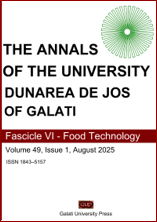Improving the Rosé wines quality through the Saignée technique
Abstract
The saignée technique involves starting the vinification of black grapes using red wine technology, mentioning that, after a short period, a part of the must is vinified according to the rosé technology (white vinification). The technique was meant to differentiate it from other winemaking methods, highlighting the varietal characteristics of the grape varieties and the climate and soil. The study’s objective was to test the Saignée technique for the most representative native grape variety, Fetească Neagră, in the pedoclimatic and cultural conditions of the southern wine region of Romania, the Danube Terraces Region. Both wines - obtained by direct pressing and by the Saignée technique - may withstand potential long-term aging, according to the results of the physicochemical studies, which also showed higher stability and age potential, total and volatile acidity, pH, and free and total SO2 levels. In terms of color parameters, rosé wines showed a mixed behavior, reflecting characteristics typical of both red and white wine evolution. Sensory analysis showed that Saignée wine was usually better enjoyed, scoring higher in several categories: smell, taste, aroma, aftertaste, roundness, full-bodied, and general appreciation. The traditional rosé wine was valued for its beauty and freshness.


